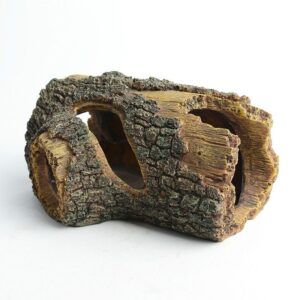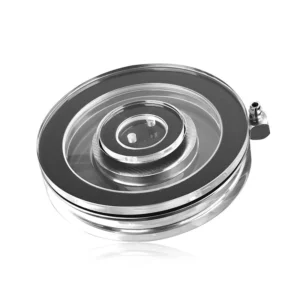When you set up a home aquarium, put the fish in your tank, and cycle it, and the next important step is to choose aquarium decorations. Why do you need decorations for tanks? Here, we’ll discuss the most popular stone and wood decorations for freshwater aquariums and hope you can choose the proper aquarium decorations to build the best aquarium world.
Content Table
Aquarium Stone Decorations
Slate
Slate is a dark, smooth rock, but with sharp edges. Usually, in the shape of a flat plate, it can be used for stacking and constructing small bridges across gaps. It can be easily split and broken with a hammer and is inert, suitable for any freshwater aquarium.
Cobblestone
Pebbles are medium to large smooth stones, inert, and suitable for all freshwater aquariums. Large pebbles are typical materials for aquatic landscapes in the style of creeks, rivers, and Lake Malawi. Because of its hard and heavy texture, it is not easy to stack, so in most cases, it can only be placed on one layer. The smooth edges make them suitable for aquariums with awkward species, such as all kinds of exotic goldfish.
Ocean rocks
Marine rocks were originally limestone formed in the ocean. Limestone is only suitable for marine fish and hard water and freshwater fish. Its bright colors and prominent shapes can be used to build scenarios with typical structures, or it can be used as a cornerstone on which other more expensive rocks are placed. It can be stacked on its own, but it will be very heavy, so measures must be taken to ensure that it does not fall and break the glass of the aquarium.

mountain in aquarium
Travertine
Travertine is a soft and porous calcium carbonate rock (calcite) that is only suitable for hard water, freshwater aquariums, or seawater aquariums. With bright colors and soft texture, you can drill this kind of stone yourself at home to create different caves. It can be stacked, and when used in combination with coral sand, it can display a kind of ocean landscape in a freshwater aquarium. Now, this kind of stone is not used often, because some experts believe that this kind of stone can accumulate and release nitrates into water.
Volcanic rock
A lighter stone with a special texture formed by a volcanic eruption. The common ones on the market either have carved holes or block structures. They are easily stacked high and are very light. Even if it falls, it will hardly cause any damage to the aquarium. The volcanic rock is inert and suitable for any aquarium, but its rough surface is not suitable for fish that eat algae or clumsy and goldfish of weird shapes. Check whether it is sinking before buying, because some volcanic rocks are very light, full of air inside, and will float in the water.
Fossil wood
Fossil wood is wood that has become rock thousands of years ago. It is inert and eye-catching and can be used in all freshwater aquariums, from cold water aquariums, and cichlid aquariums to aquatic plants. Fossil wood is quite heavy, the more you use it, the better it looks.
Term interpretation
Inert materials will not leach or release any material into the water, or affect the pH and hardness of the water. They are suitable for all freshwater bodies.
The calcareous material is composed of calcium carbonate or calcium-containing materials. Calcium is water-soluble and can increase the pH and hardness of water. Therefore, calcareous materials are only suitable for hard water fish that like high pH.
Wood
Driftwood
Driftwood is now an all-encompassing name for any wood used in aquariums, and this driftwood rarely comes from swamps. But driftwood must be submerged in water and must be safe with the fish, so only the driftwood provided by the aquarium can be used.

driftwood in aquarium
Driftwood comes from all over the world and comes in many different sizes and textures. It can range from large and heavy chunks of wood to complex branch-like structures and is very popular when creating natural landscapes in tropical aquariums. The wood will release tannins and dye the water body brown, which is normal. Many fishes also live in tannin-dyed water in the wild natural environment. If you don’t want brown water in your aquarium, you can use activated carbon to remove tannins or soak the wood for several weeks before using it. Before placing the wood in the aquarium, it is wise to soak the wood first.
Branches and leaves
To create an exaggerated wild effect, leaves and branches can be used. In the wild natural environment, this situation always exists, especially with many catfish camouflaged in the color of bark or leaves. Combining it with fine sand can create a lifelike Amazonian original ecological landform.
However, there is a hidden danger in using leaves and branches. They decompose and rot in water and may produce mold. Therefore, in many cases or for beginners, it is not recommended to use them. If you use them, you should combine a large amount of water change and filtration. It is best not to use any leaves, as some are poisonous, but you can use some Terminalia Catappa Leaves because they are one of the miracle cures in aquariums. If you must use it, then the leaves of beech and oak trees are safe, as are their branches. Boil these branches and leaves before use, so that they are submerged in water and disinfected.


Leave a comment